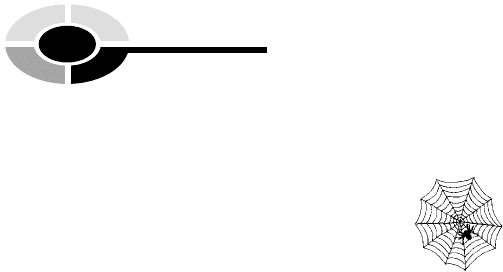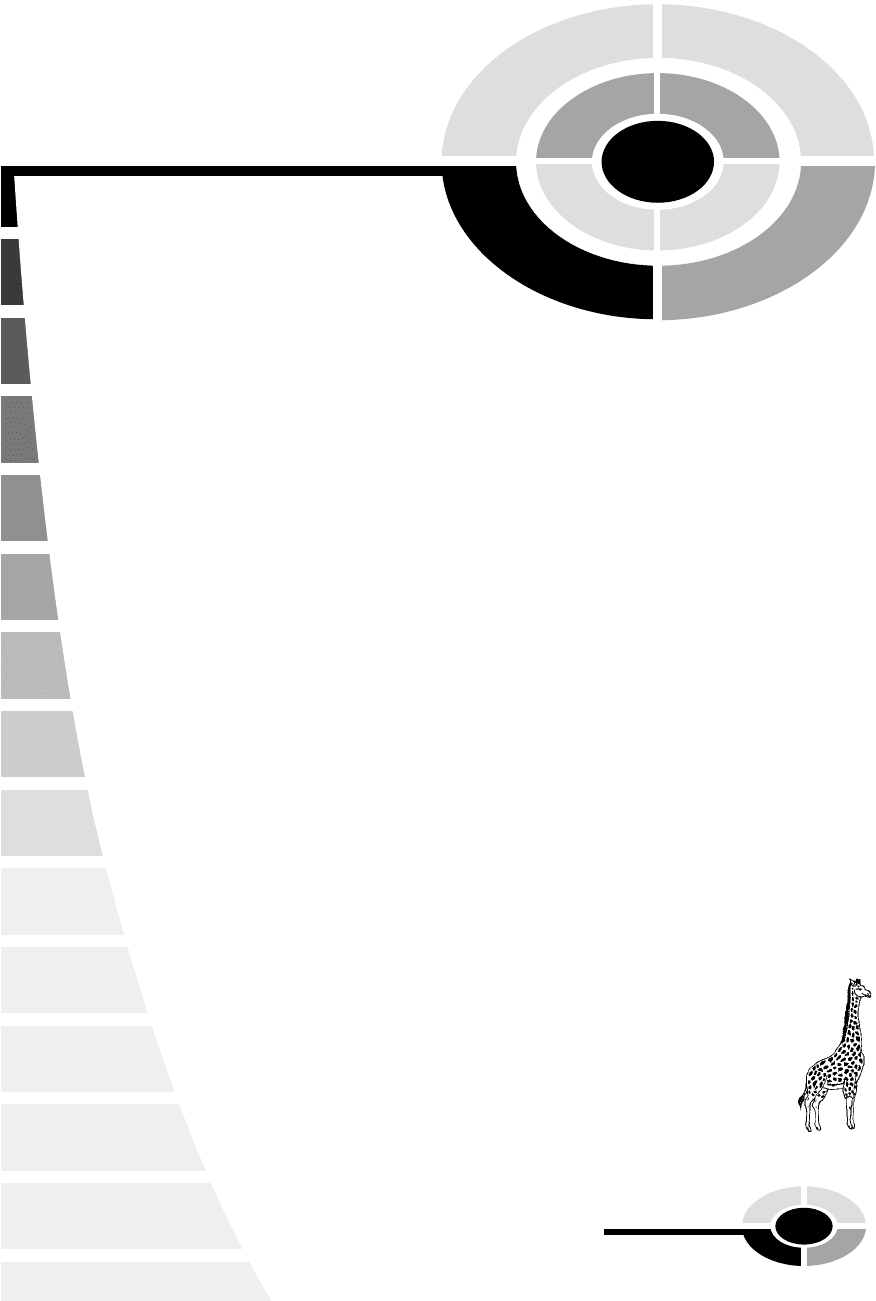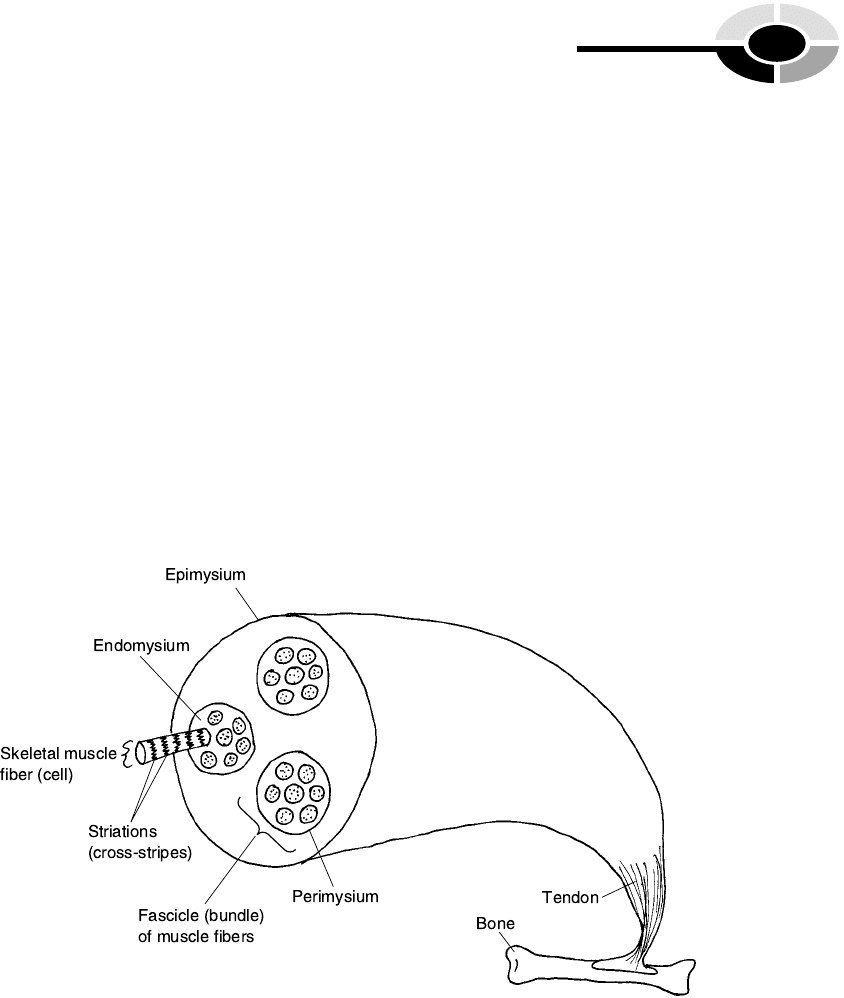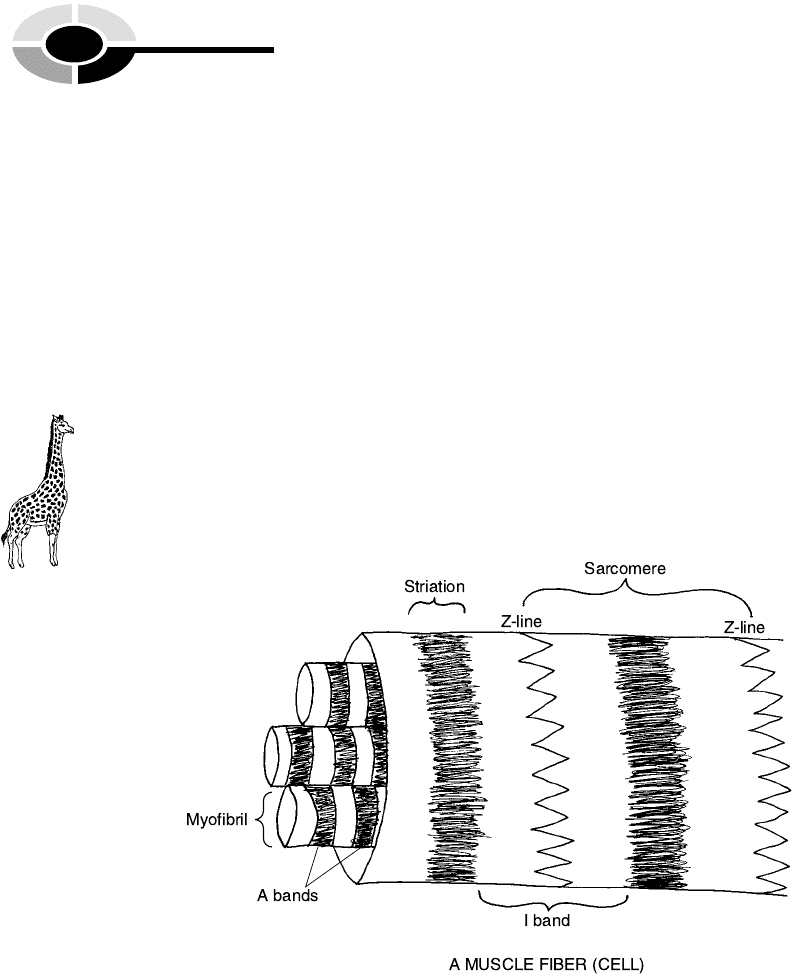Layman D. Biology Demystified: A Self-Teaching Guide
Подождите немного. Документ загружается.


10. The sharp crystals covering bone collagen fibers are largely composed
of:
(a) Calcium phosphate
(b) Magnesium sulfide
(c) Chlorophyll pigment
(d) Melanin
The Giraffe ORDER TABLE for Chapter 13
(Key Text Facts About Biological Order Within An Organism)
1. ____________________________________________________________
2. ____________________________________________________________
3. ____________________________________________________________
4. ____________________________________________________________
5. ____________________________________________________________
The Dead Giraffe DISORDER TABLE for Chapter 13
(Key Text Facts About Biological Disorder Within An Organism)
1. ____________________________________________________________
2. ____________________________________________________________
3. ____________________________________________________________
CHAPTER 13 Skins and Skeletons 237
[13:25 13/6/03 N:/4058 LAYMAN.751/4058-Alltext.3d] Ref: 4058 Layman: Biology Demystified All-text Page: 237 1-388

The Spider Web ORDER TABLE for Chapter 13
(Key Text Facts About Biological Order Beyond the Individual Organism)
1. ____________________________________________________________
[13:25 13/6/03 N:/4058 LAYMAN.751/4058-Alltext.3d] Ref: 4058 Layman: Biology Demystified All-text Page: 238 1-388
PART 4 Anatomy and Physiology of Animals
238

[13:25 13/6/03 N:/4058 LAYMAN.751/4058-Alltext.3d] Ref: 4058 Layman: Biology Demystified All-text Page: 239 1-388
239
CHAPTER
14
The Neuromuscular
(Nerve–Muscle)
Connection
Chapter 13 discussed the structure and function of the skin and skeleton.
Chapter 14 considers the neuromuscular (nur-oh-MUS-kyoo-lar) or ‘‘nerve’’
(neur) and ‘‘muscle’’ (muscul) connection. Quite fascinating is that the word
muscular (MUS-kyoo-lar) actually translates to mean ‘‘pertaining to a little
mouse (muscul)’’!
Literally speaking, then, the muscular system of humans is an organ system
composed of over 600 individual ‘‘little mice’’ – the skeletal muscle organs.In
reality, the skeletal muscle organs are a large group of individual skeletal
muscles that get their name from the fact that they are attached to the bones
of the skeleton (Figure 14.1). [Study suggestion: Flex or bend your forearm.
Now, extend or straighten it. Observe how your biceps (BUY-seps) brachii
(BRAY-kee-eye) muscle bulges, then lengthens, deep to the skin in your
upper arm. Try to duplicate the imagination of the early anatomists, by
1, Order
Copyright 2003 by The McGraw-Hill Companies, Inc. Click Here for Terms of Use.

speculating why they called muscles like the biceps brachii the ‘‘little mice.’’
Check your thinking with the diagram in Figure 14.1, below.]
Bone–Muscle Lever Systems
Just as little mice run up-and-down, the skeletal muscles contract and
shorten, then relax and lengthen, again. Each of the skeletal muscles is
attached to a bone of the skeleton by two or more tendons (TEN-duns). A
tendon is literally a ‘‘stretcher.’’ It is actually a strap of dense fibrous con-
nective tissue that anchors a skeletal muscle to a bone. When the muscle
[13:25 13/6/03 N:/4058 LAYMAN.751/4058-Alltext.3d] Ref: 4058 Layman: Biology Demystified All-text Page: 240 1-388
PART 4 Anatomy and Physiology of Animals
240
Fig. 14.1 An overview of the human muscular system: A collection of ‘‘little mice.’’

contracts, it exerts a pulling force, P. This pulling force stretches the tendon.
The tendon then pulls upon the bone.
The human body has a number of bone–muscle lever (LEE-ver) systems.A
lever is a rigid bar that is acted upon by some force. In a bone–muscle lever
system (Figure 14.2), the bone serves as a passive lever or rigid bar that is
pulled upon by a contracting skeletal muscle. The pulling force of the muscle
is applied to the bone through the attached tendons.
A fulcrum (FULL-crumb), abbreviated as F, is a place of ‘‘support’’ upon
which a lever turns or balances when it moves. Within a muscle–bone lever
system, a movable joint generally serves as the fulcrum. For instance, the
biceps brachii contracts and provides a pulling force (P) upon its tendons.
The tendons raise the bones of the forearm (the levers) at the elbow joint,
which serves as the fulcrum (F). A weight (W) or resistance (R) is then lifted,
as the forearm is bent or flexed.
CHAPTER 14 Neuromuscular Connection 241
[13:25 13/6/03 N:/4058 LAYMAN.751/4058-Alltext.3d] Ref: 4058 Layman: Biology Demystified All-text Page: 241 1-388
Fig. 14.2 A bone–muscle lever system.
Some Characteristics Used for Naming Muscles
Back in Figure 14.1, you were given anterior (front) and posterior (rear)
views of several major muscles of the human body, along with their names.
Since this book is entitled Biology Demystified, we want to help you take
some of the ‘‘mystery’’ out of these muscle names! To do this, we will exam-
ine some of the general characteristics or criteria frequently employed to
name major skeletal muscles.

Characteristic #1: Body location. Many muscles are either totally or par-
tially named for their body location. Consider, for example, the tibialis (tih-
bee-AL-is) anterior muscle. From Figure 14.1, you can see that this muscle is
named for its location ‘‘in front of ’’ (anterior) to the tibia (TIB-ee-ah) or
‘‘shin bone.’’ The name tibia also means ‘‘pipe’’ or ‘‘flute,’’ apparently from
its shape. The tibia (and its associated skeletal muscles) is found not just
within humans but also in amphibians, reptiles, birds, and other mammals.
Characteristic #2: Muscle shape. Just as the tibia bone (and hence the
tibialis anterior muscle) is partially named for its resemblance to an ancient
Roman flute, various skeletal muscles are likewise named for their shapes.
Look at the deltoid (DELL-toyd) muscle (Figure 14.1). This muscle ‘‘resem-
bles’’ (-oid) a ‘‘triangle’’ (delt) in the upper shoulder area.
Characteristic #3: Points of attachment. Remember that each skeletal mus-
cle is attached to a bone by one or more tendons at either end. The origin of a
muscle is the least movable tendon or attachment of the muscle. Picture it like
a heavy anchor. The origin of the biceps brachii muscle, for instance, is at the
bones of the shoulder. The insertion of a muscle, on the other hand, is the
more movable tendon or attachment. The insertion of the biceps brachii is
made upon the bones in the lower arm.
Within a particular bone–muscle lever system, then, when the muscle con-
tracts and exerts a pulling force, only the insertion end moves. The origin end
remains stationary, because it is firmly anchored. During contraction, the
insertion end of a muscle moves towards the origin end. In the case of the
biceps brachii, when it contracts its lower tendons flex (FLEKS) or ‘‘bend’’
the arm at the elbow joint. [Study suggestion: Put down this book for a
moment and flex your own forearm. Try to imagine the lower tendons of
your biceps brachii pulling upon their insertion on your forearm bones to
raise your lower arm.]
Some muscles are even named for their points of attachment (origin and
insertion). A good example is provided by the sternocleidomastoid (ster-noh-
kleye-doh-MASS-toyd) muscle. Figure 14.3 reveals that this muscle attaches
to the sternum (STER-num) or main bone of the ‘‘chest’’ (stern). Its tendons
also hook onto the clavicle (KLAV-uh-kul) or collar bone, which is named
for its resemblance to a ‘‘little key’’ (clavicul) used in ancient times. Finally,
the sternocleidomastoid tendons attach to a third place – the mastoid
(MASS-toyd) process of the skull – which literally ‘‘resembles’’ (-oid) a ‘‘little
breast’’ (mast).
When the sternocleidomastoid contracts, it nods the head, drawing the
chin down upon the chest. [Study suggestion: From the preceding informa-
tion, which attachment do you think represents the insertion end of the
sternocleidomastoid? – What attachments are the origin end?]
[13:25 13/6/03 N:/4058 LAYMAN.751/4058-Alltext.3d] Ref: 4058 Layman: Biology Demystified All-text Page: 242 1-388
PART 4 Anatomy and Physiology of Animals
242
2, Order

Characteristic #4: Relative size. Some muscles are named for their relative
size: that is, how big they are compared to their neighbors. Consider two
muscles in the gluteal (GLOO-tee-al) or ‘‘rump’’ region – the gluteus (GLOO-
tee-us) maximus (MACKS-ih-mus) and the gluteus minimus (MIN-ih-mus).
[Study suggestion: Which do you think is the larger muscle, the one with a
more ‘‘minimum’’ or more ‘‘maximum’’ size?]
Characteristic #5: Number of muscle ‘‘heads.’’ A muscle head is a major
division of a muscle, with one or more tendons attached. In Latin, ceps
(SEPS) means ‘‘head,’’ while bi- denotes ‘‘two.’’ Biceps (BUY-seps), there-
fore, means ‘‘two-headed.’’
Brachii (BRAY-kee-eye) stands for ‘‘arm.’’ Hence, the name of the biceps
brachii muscle translates exactly to mean a ‘‘two-headed’’ muscle in the
upper ‘‘arm.’’ The biceps brachii has two major heads or divisions to it, and
is hooked onto bones by two tendons above the muscle, and two below it.
Characteristic #6: Direction of muscle fibers. Several muscles are given
Latin names describing the direction of their individual muscle fibers –
CHAPTER 14 Neuromuscular Connection 243
[13:25 13/6/03 N:/4058 LAYMAN.751/4058-Alltext.3d] Ref: 4058 Layman: Biology Demystified All-text Page: 243 1-388
Fig. 14.3 The sternocleidomastoid muscle and its attachments.

long, slender, fiber-shaped muscle cells. Consider the rectus (WRECK-tus)
abdominis (ahb-DAHM-ih-nus) muscle. (Review Figure 14.1.) It is located in
the front of the abdomen (trunk midsection), and its fibers are oriented in a
‘‘straight’’ (rect), vertical direction.
Characteristic #7: Association with real or mythological characters. Certain
muscles are associated with real people, or with people who only existed in
myth. A very intriguing example is the sartorius (sar-TOR-ee-us). This muscle
oddly means ‘‘presence of ’’ (-us) a ‘‘tailor’’ (sartori)! The naming connection
is to the way tailors used to sit in ancient times – cross-legged upon the
ground (Figure 14.4). The sartorius is actually located along the inner aspect
of each thigh. Thus, when it contracts, it flexes (bends) the lower leg, as was
done by ancient tailors who used to sit on their bent legs!
Characteristic #8: Major body actions. Some muscles are named for their
major body actions. Consider as an example the masseter (mah-SEE-ter)
muscle in the lower jaw. Its name comes from Latin for ‘‘chewer.’’ You
use the masseter to lift your lower jaw as you chew meat or gum, of course!
The General Anatomy of a Skeletal Muscle
We have been considering the specific names and appearances of various
skeletal muscles. But there is also a general anatomy that practically all
skeletal muscles share.
[13:25 13/6/03 N:/4058 LAYMAN.751/4058-Alltext.3d] Ref: 4058 Layman: Biology Demystified All-text Page: 244 1-388
PART 4 Anatomy and Physiology of Animals
244
Fig. 14.4 The sartorius: A tale about tailors!

Figure 14.5 includes examples of fascia (FASH-ee-uh). A fascia is a thin
‘‘band’’ (fasci) of fibrous connective tissue surrounding or penetrating a
muscle. Consider, for instance, the epimysium (ep-uh-MIS-ee-um), which is
a sheet or band of fascia that is ‘‘present’’ (-um) ‘‘upon’’ (epi-) the entire
‘‘muscle’’ (mys). [Study suggestion: Look at a raw piece of chicken. Peel the
skin back slightly from the flesh, and you will see a milky looking membrane
lying upon the meat. What is the name of this membrane?]
Cutting the muscle in half, we can view the perimysium (pair-uh-MIZH-ee-
um). The perimysium penetrates deeply into the muscle organ and subdivides
it into fascicles (FAS-uh-kuls) – ‘‘little bundles’’ of muscle fibers that are
surrounded by sheets of fascia. The perimysium, therefore, is the fascia pre-
sent ‘‘around’’ (peri-) each bundle or fascicle of muscle fibers.
Finally, the endomysium (en-doh-MIZH-ee-um) is the fascia present
‘‘within’’ (endo-) each bundle or fascicle, and between its individual muscle
fibers. You will note from Figure 14.5 that the skeletal muscle fibers, them-
selves, are striated (STRY-ay-tid) or ‘‘furrowed,’’ that is cross-striped with
blackish lines.
STRUCTURES WITHIN THE MUSCLE FIBERS
An important question for us to ask is, ‘‘Okay, but so far we haven’t learned
how the internal anatomy of a skeletal muscle explains how it contracts
(shortens) and provides the pulling force for body movements.’’
CHAPTER 14 Neuromuscular Connection 245
[13:25 13/6/03 N:/4058 LAYMAN.751/4058-Alltext.3d] Ref: 4058 Layman: Biology Demystified All-text Page: 245 1-388
Fig. 14.5 The internal anatomy of a skeletal muscle.

Ultimately, the answer to this question will require us to examine the inner
anatomy of an individual skeletal muscle fiber, which is actually a long, fiber-
shaped cell.
As Figure 14.6 reveals, the striated (cross-striped) muscle cell or fiber
contains numerous myofibrils (my-uh-FEYE-brils). The word myofibril
literally means ‘‘little fiber’’ (fibril) of a ‘‘muscle’’ (my). Each of these myofi-
brils is actually a slender, fiber-shaped, cell organelle. The myofibrils have a
dark-and-light banding pattern. The dark bands are called the A bands, while
the light bands are called the I bands. The striations (stry-AY-shuns) or cross-
stripes of each muscle fiber, then, in reality just represent the dark A bands of
their myofibrils, stacked one upon the other to make a stripe.
Within the middle of each light I band is a dark, zig-zagging Z-line. These
dark lines mark off a series of sarcomeres (SAR-koh-meers). A sarcomere is a
short ‘‘segment’’ (-mere) of ‘‘flesh’’ (sarc): that is, a region of myofibril
between two Z-lines. Hence, each myofibril organelle within a muscle fiber
basically consists of a series of sarcomeres, attached end-to-end.
Myofilaments and the Sliding Filament Theory
Whether one is considering the contraction of muscles in humans, fish,
amphibians, reptiles, birds, or practically any other vertebrate animals, the
[13:26 13/6/03 N:/4058 LAYMAN.751/4058-Alltext.3d] Ref: 4058 Layman: Biology Demystified All-text Page: 246 1-388
PART 4 Anatomy and Physiology of Animals
246
Fig. 14.6 A look within a muscle fiber (cell).
3, Order
